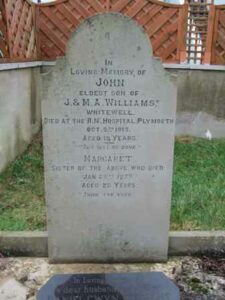The Village of Penally is situated just a few miles along the south Pembrokeshire coast from Tenby. The village and surrounding area is rich with history, dating back to the Bronze Age, and was an important Medieval Manor. Recently Penally has become more well-known due to its military firing range and also due to the tourist industry. The War Memorial to the fallen of Penally Village in both World Wars takes the form of a granite block, set in a memorial garden, with a marble plaque affixed, listing the names of the fallen. There are older marble plaques inside the Parish Church at Penally, which commemorate the fallen of the Great War and also the two sons of Lord St. David’s who fell, and another in Penally Congregational Chapel, which commemorates eight members of its Congregation who fell during the Great War. This page commemorates those eight men named on the Penally Congregational Chapel Memorial. The photograph of the memorial is courtesy of Dr Gethin Matthews, of Swansea University.
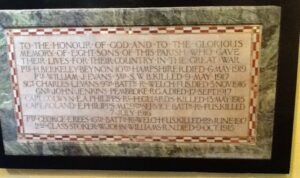
The Great War, 1914-1918
Harold Berkeley Beynon, Private, 33181, Hampshire Regiment. Harold was the son of Thomas and Laura Annie Beynon, of Holloway, Penally. He later resided at St. Johns Hill, Tenby. Harold enlisted into the Pembroke Yeomanry on 1 April 1914, then served with the 3rd Welsh, before being posted to the 10th Battalion, Hampshire Regiment. The Battalion became attached to 29 Brigade, 10th Division, and on 7 July 1915 sailed from Liverpool, arriving at Mudros 26 July 1915. The Battalion landed on Gallipoli on 6 August 1915, and fought there for a month before being sent to Salonika, where it joined 82 Brigade, 27th Division. Harold became ill with malaria while in Salonika and returned home for treatment. His service papers show that he was discharged in 1919 due to malaria. Sadly Harold died of meningitis and encephalitis soon after, on 16 May 1919, aged 21. Harold was accepted for commemoration by the CWGC (Friday 13 January 2012). His grave has recently been discovered at St. Florence (St. Florencius) Churchyard, and evidence has recently been sent to the CWGC in order to prove the location of his last resting place.
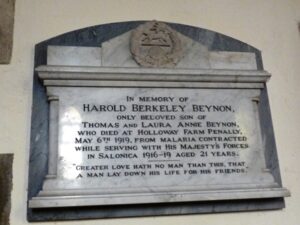
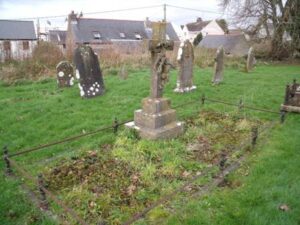
Charles Evans, Sergeant, 8439, Royal Welsh Fusiliers. Charles was born in 1886, the son of James and Jane Evans, of Alma, Penally. He had married prior to the outbreak of the war, and lived with his wife Sarah H. M. Evans, at 34, Sunny Bank Street, Aberaman, near Aberdare. Charles enlisted at Cardiff into the Army, and was posted to the 9th Battalion, Royal Welsh Fusiliers, which was attached to 58 Brigade, 19th (Western) Division. The Division had moved to France in the summer of 1915, and saw its first major action during the Battle of Loos on 25 September 1915. It moved to the Somme by the summer of 1916, and took part in the initial attack against the village of La Boiselle. The Division remained on the Somme throughout the battle, and sometime in October, Charles became wounded. He was evacuated to the military hospital at Abbeville for treatment, but sadly died of wounds there on 3 November 1916. Charles was 30 years old, and is buried at Abbeville Communal Cemetery Extension, France.
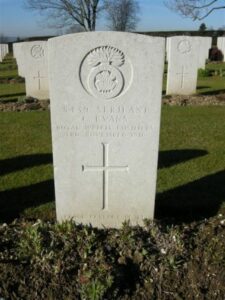
William John Evans, Private, 19094, South Wales Borderers. William was born in 1889, the son of George and Martha Jane Evans, of Frankleston, Penally. He enlisted at St. Leonard’s into the Army, and was posted to the 7th Battalion, South Wales Borderers, which was attached to 67 Brigade, 22nd Division. William landed in France on 5 September 1915, however it’s stay in France was to be very short. On 27 October 1915 the Division, having been moved by train to Marseilles, began to embark for Salonika. It completed concentration there in November, and took part in the retreat from Serbia during December, 1915. It remained there for the duration of the war, fighting in several battles, there. It was during a later action, at the Battle of Doiran on 9 May 1917, that William was fatally wounded and died. He was 27 years old, and is buried at Karasouli Military Cemetery, Greece.
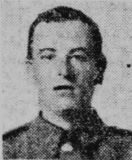
John Lewis Jenkins, Gunner, 371277, Royal Garrison Artillery. John was born in Penally Village in 1899, the son of Lewis and Selina Jenkins, later of Treberth Farm, Saundersfoot. He enlisted into the Royal Garrison Artillery, and was posted to their 409th Siege Battery, which was attached to the Third Army. John was wounded during Third Ypres, and brought to the Casualty Clearing Station at Vlamertinghe, where he died of wounds on 17 September, 1917 aged 19. He is buried there, at Vlamertinghe New Military Cemetery.
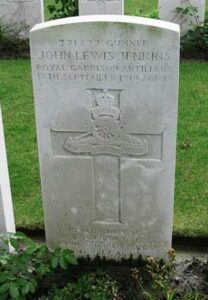
The Honorable Colwyn Erasmus Arnold Philipps, Captain, Royal Horse Guards. Colwyn was born on 11 December 1888, the son of John Philipps, the Right Honorable the 1st Viscount St. David’s, P.C. and his wife, Leonora Gerstenberg, of 3, Richmond Terrace, Whitehall, London. He was educated at Eton and Sandhurst. At the age of 20 he received a Commission into the Royal Horse Guards, then on 30 July 1909 had been promoted to full Lieutenant, and was Captain by the outbreak of war. The R.H.G. were attached to the 7th Cavalry Brigade, 3rd Cavalry Division on 1 September 1914 and landed at Zeebrugge at the beginning of October. They fought in the defence of Antwerp before being sent to Ypres, taking part in the First and Second Battles of Ypres. It was during Second Ypres, at the Battle of Frezenberg, that Colwyn was killed in Action on 13 May 1915, aged 26. He is commemorated on the Ypres (Menin Gate) Memorial, on Panel 3. In a letter sent to his bereaved parents by a brother Officer, it was said “He fell in an attack on the German Trenches on Thursday, 13th. His end was worthy as his life, as he was the first man in the German trenches and killed five Germans before he was shot in the head at close quarters and instantly killed.” His brother Roland also fell. During his short life, Colwyn had gained a strong reputation for his poetry, putting him on the list of the famed War Poets of the Great War. His poems were published after his death.
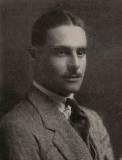
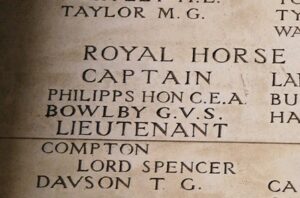
The Honorable Roland Erasmus Philipps, MC, Captain, Royal Fusiliers. Roland was born on 27 February 1890, the second son of John Philipps, the Right Honorable the 1st Viscount St. David’s, P.C. and his wife, Leonora Gerstenberg, of 3, Richmond Terrace, Whitehall, London. He was educated at Winchester College and New College, Oxford. Roland was an important early member of the Boy Scouts. In July 1912 he was appointed Assistant District Commissioner for East London. In 1913 he was appointed Commissioner for North East London, and in November 1913 he was made responsible for all of East London. Roland was commissioned into the 9th Battalion Royal Fusiliers, part of 36 Brigade, 12th Division. The Division assembled at Shorncliffe during August 1914 and moved to France at the end of May 1915. Their baptism of fire was at Ploegsteert Wood on 23 June 1915, and later at the Battle of Loos. They held the line at Loos until June, and they were moved in readiness for the Somme Offensive. They relieved the decimated 8th Division at Ovillers-la-Boiselle on 1 July, and took two lines of German trenches, but then stuttered to a halt. On 7 July 1916 the Brigade attacked again, but were decimated by German shell-fire in Mash Valley, but still managed to capture their objective of Ovillers. Roland was killed in Action this day, aged 26. He is buried in Aveluy Communal Cemetery Extension, Grave H. 32. His brother Colwyn also fell.
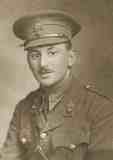
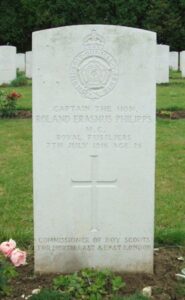
George Ernest Rees, Private, 55444, Royal Welsh Fusiliers. George was born at Llanboidy in 1896, the son of Thomas and Elizabeth Rees. The family later moved to Kiln Park, Penally. George enlisted at Tenby early in the war into the Pembrokeshire Yeomanry, with the service number 373. He was then transferred into the Royal Welsh Fusiliers, and posted to their 16th Battalion, which was in France as part of 113 Brigade, 38th (Welsh) Division. George joined the Division as one of a batch of reinforcements after the fighting at Mametz Wood in July 1916. The Division had then been pulled from the line, and took up positions in the line north of Ypres, at Boesinghe, where it was to remain for twelve months. George was killed in action at Ypres on 22 June 1917, while his Battalion was in the front line at the canal bank. He was 21 years old, and is buried at Bard Cottage Cemetery, Belgium.
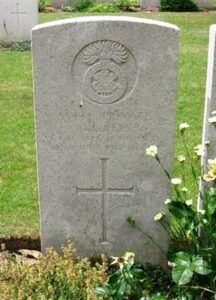
William John Williams, Stoker 2nd Class, K/23943, Royal Navy. William was born on 12 December 1896, the son of James and Mary A. Williams, of East Lodge, Penally. He enlisted into the Royal Navy on 20 January 1915, and was stationed at the Royal Naval Barracks at HMS Vivid II, Portsmouth to train as a Stoker. William took ill and died of fibrous lung on 9 October 1915. He was 18 years old, and is buried at Penally Congregational Chapelyard.
